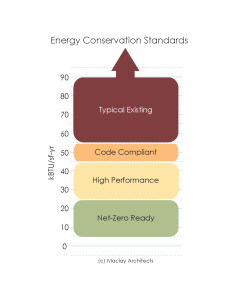In our GBA guest blog on August 26th , and our Net Zero Energy Vermont blog, we posed a question concerning net zero (NZ) statistics and metrics.
What are the metrics that will move us toward our net zero goal and future?
When we purchase a car we generally know what the fuel mileage is. When we buy, own, renovate or build a new building there isn’t a simple metric to compare buildings. To accomplish this goal the critical questions are:
- How do we compare different sized buildings?
- What is a simple and easy standard that is as intuitive as miles per gallon so it is understandable, applicable and useful?
- What is the typical energy consumption?
- How do we compare different building occupancies and uses (like office, residential, retail, dining)
- What is a standard that is appropriate for a net zero building?
To compare different sized buildings we can total annual energy consumption and divide by the size of the building. This metric is called energy use intensity or energy utilization index (EUI). For a step by step method to accomplish this, you can use this EUI Calculator that we’ve developed. This resource can also be found through the Maclay Architects Resources page on our website.
Benchmarking
We can benchmark typical existing building EUI’s by checking the EPA Commercial Building Energy Consumption Survey (CBECS) data at http://www.eia.gov/consumption/commercial/reports/2012/preliminary/index.cfm. We can estimate typical new code complaint building EUIs. Also, ten US cities have required that large commercial, institutional, and residential projects disclose their EUIs, so those can be used for comparison.
 For net zero buildings we can establish recommended EUI metrics. For cold climates, the chart shown here identifies our recommended EUI metrics for net zero ready (NZR) buildings and compares them to existing and code compliant buildings without excessive process loads like kitchens, manufacturing, labs, etc.
For net zero buildings we can establish recommended EUI metrics. For cold climates, the chart shown here identifies our recommended EUI metrics for net zero ready (NZR) buildings and compares them to existing and code compliant buildings without excessive process loads like kitchens, manufacturing, labs, etc.
This benchmark, metrics, and goal process is not perfect. It does not fully account for density of use, different building occupancies, capacity of people served and other variables. It is a metric that buildings can be designed to and then measured with past occupancy monitoring. Comments on our recent GBA article (Aug. 26) have offered useful considerations. Related to that, in Chapter 2 of The New Net Zero we have also offered additional considerations. However, in summary, we think EUI most effectively serves the need to have a simple, comprehensive, and easy metric that is similar to gas mileage for cars that can be implemented and used today to move toward a net zero world and future.